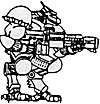
Killzone is a simple set of SF skirmish rules, which were originally put out by Grenadier a few years ago, and were supported by an excellent range of figures (the rules and figures are now available via Valley Design). The rules are designed for small squads of troopers, or gangs of Scavengers and Savages, operating in the near future, in a period after some unspecified disaster or breakdown in civilisation (think of the Mad Max series of films or Escape from New York and Escape from L.A. and you're pretty much there). One pleasing aspect of these rules is that, although there are supporting figures and generic classes of units (troopers, gangs, rebels) there isn't reams of background material tying it together and limiting the imagination.
After a few unrelated games I have begun to develop a background based on a near future Europe which has splintered into many smaller states, and has taken up an almost medieval political appearance. I have concentrated on two nations, Greater Franconia and Lower Varbaria. Greater Franconia operates a dictatorial government from which the much smaller state of Lower Varbaria seceded in the year 2055. Greater Franconia has never really been happy with this state of events and there has been a continual state of armed aggression between the two countries. This has led to the creation of a buffer area of semi-ruinous towns and empty country along the frontier region between the two countries.
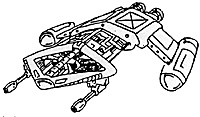 Armed Patrols
Armed Patrols
For a solo game in this frontier region I came up with the not wholly original idea of one side sending out armed patrols into ill-mapped territory. A flick of a coin gave me (as active player) the Greater Franconian troops, whom I would pitch against unknown numbers of rebel Lower Varbarians and/or unknown criminal gangs.
The first need was, then, to establish how many troops I had at my command. Killzone operates on a squad basis, with each trooper squad having 5 troopers when at full strength. A 5 man squad consists of a leader, a subleader and three troopers. I decided that I'd randomise the squad size slightly using Table 1.
| Table 1 : Trooper squad selection | |
|---|---|
| Die Roll | Result |
| 1 | Full strength. Leader, Subleader & 3 troopers. |
| 2 | Full numerical strength. Leader & 4 troopers. |
| 3 | Sub-strength. Leader, Subleader & 2 troopers. |
| 4 | Sub-strength. Subleader & 3 troopers. |
| 5 | Sub-strength. Leader & 3 troopers. |
| 6 | Experienced and full strength. Hero leader, Subleader & 3 troopers. |
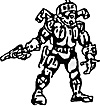 The figures for each squad are then chosen at random from those available in order to produce a random selection of sidearms and other equipment. If a figure with a heavy weapon such as a missile launcher is selected then roll 1D4+1 (i.e. a range of 2-5) for the number of missiles the trooper has been issued. I usually don't allow any squad to have more than 1 of each heavy weapon (so, only one missile launcher, one light assault cannon, etc).
The figures for each squad are then chosen at random from those available in order to produce a random selection of sidearms and other equipment. If a figure with a heavy weapon such as a missile launcher is selected then roll 1D4+1 (i.e. a range of 2-5) for the number of missiles the trooper has been issued. I usually don't allow any squad to have more than 1 of each heavy weapon (so, only one missile launcher, one light assault cannon, etc).
I assume that the squad(s) is based in a safe home territory of one table size (4 feet by 3 feet works quite well for a Killzone skirmish). This should consist of security fencing, bunkers, a patrolled perimeter, watch towers and so on. When moving off the home base generate random terrain as follows. Keep a record of all areas thus generated for later patrolling.
Divide the game board into twelve zones each one foot by one foot. If the board is being entered from a road then the road is automatically connected with it on the new board. First dice for roads and routes; using a D6 1-2 gives one route, 3-4 gives 2 and 5-6 gives 3. Then dice for where the road route goes.
| Table 2 : Road Routes | ||
|---|---|---|
| Die Roll | From | To |
| 1 | North | South. |
| 2 | North | East. |
| 3 | North | West. |
| 4 | South | East. |
| 5 | South | West. |
| 6 | East | West. |
Dice for which sections the road runs between on the 4' by 3' board (assume long edges are North and South). So, for example, a roll of 3 on table 2 gives a road North to East, there are 4 subdivisions on the North edge, a roll of 1 on a D4 indicates that the road originates on the most Westerly subdivision, a roll of 3 or 4 on a D6 indicates that it runs to the middle subdivision of the Easterly board edge and so on for any other roads. Any duplicate routes means that the road is a two lane major road. Next dice for the terrain type for each square of the board.
Table 3 : Terrain types
-
1: Clear
2: Clear
3: Rubble
4: Building
5: Building
6: Ruined building
7: Woodland/Park
8: Park with fencing; (1-3 low wooden fencing, 4-5 security fencing, 6 high concrete fencing)
9: Rubble
10: Special
Dice again for special terrain
Table 4 : Special terrain
-
1: Bunker
2: Park with Lake
3: Canal/River (if crossed by a road then any bridge has a 50-50 chance of having been destroyed)
4: Marshy area
5: Hill, 1-3 wooded, 4-6 clear
6: Shell craters
Roll again for rivers. 1-3 runs North to South, 4-6 Runs East to West. Trace rivers across the board to join with another river on an already explored area, or, if this is not possible, trace to an unexplored board.
Where rubble exists in the same board section as a road, dice to see if the road is blocked; 1-3 half-blocked, 4-5 Fully blocked, 6 - road is clear.
Having decided what the table looks like, the squad can be deployed at its entry point and the opposition diced for.
Table 5 : Opponents
-
1: Scavenger Gang
2: Savage Gang
3: Scavengers and Savage gang
4-5: Rebels (Lower Varbarians)
6: Deserters
The size of a gang is determined from the following tables :
Table 6 : Scavenger Gang composition
-
1: 5 times the number of assaulting squads
2: 4 times the number of assaulting squads, plus 1 hero leader
3: 4 times the number of assaulting squads, plus 2 heroes
4: 6 times the number of assaulting squads
5: 7 times the number of assaulting squads
6: 3 times the number of assaulting squads
Table 7 : Savage Gang composition
-
1: 4 times the number of assaulting squads
2: 4 times the number of assaulting squads, plus 1 hero leader
3: 4 times the number of assaulting squads, plus 2 heroes
4: 4 times the number of assaulting squads, plus two vehicles
5: 7 times the number of assaulting squads, plus 2 vehicles, plus 1 hero
6: 3 times the number of assaulting squads, plus 1 vehicle, plus 1 hero
Table 8 : Rebels or Deserters composition
-
1: equal number of squads
2: equal number of squads, plus 1 hero leader
3: equal number of squads
4: 1 less squad, plus 2 heroes
5: 1 less squad plus 1-3 military replicants
6: 1 less squad
(Note - minimum of 1 squad, in a game with 1 assaulting squad when a roll indicates that the rebels have 1 less squad, I make the rebel squad 1 or 2 figures under strength).
As with the assaulting units, the actual composition of each enemy squad is determined by random selection from a pool of available figures.
There now remains only one more thing to determine before the game can actually be started - the objectives for the two sides. The following are sample mission tables, as I think of alternatives - or they are suggested from playing a game - then I extend the tables.
Missions:
| Greater Franconian Trooper Squads: | |
|---|---|
| 1 - 2 | Patrol over two tables and report back |
| 3 - 4 | Clear one table of rebels or gangs |
| 5 | Patrol over one table and bring back at least one undesirable per squad for questioning |
| 6 | Suspected rebel base - search the largest building on the board (search requires one man per floor, who is not involved in fighting for one turn) and report back |
| Lower Varbarian Rebels: | |
| 1 - 2 | Patrol over one table and report back |
| 3 | Rendezvous with a savage gang (generate an additional savage gang in place on the table centre) |
| 4 | Rendezvous with a scavenger gang (generate an additional scavenger gang in place on the table centre) |
| 5 -6 | Eliminate all Greater Franconian forces encountered |
| Savage gang: | |
| 1-2 | Clear this lot off your turf - eliminate as many troopers as possible |
| 3-5 | Just passing through - cross from 1 random board edge to the opposite side |
| 6 | Wanton Destruction - this area seems a bit too nice, it's about time they found about the real world ! The gang will attempt to destroy 1-3 undamaged buildings or similar, before retreating off the same able edge they entered from. |
| Scavenger gang: | |
| 1 | Clear this lot off your turf - eliminate as many troopers as possible |
| 2 - 3 | Gather additional weapons - take at least 6 weapons before retreating |
| 4 - 5 | Gather communications gear - get at least D6+1 points of communications gear. Headsets count as one point, hand data terminals as 3 points |
| 6 | Just passing through - cross from 1 random board edge to the opposite side. |
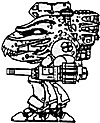 Deserters units are given the objectives of either evading capture by escape from an opposite table edge, or the elimination of all patrolling trooper squads (although I suspect that they may join up with Lower Varbarian rebels at a later date !).
Deserters units are given the objectives of either evading capture by escape from an opposite table edge, or the elimination of all patrolling trooper squads (although I suspect that they may join up with Lower Varbarian rebels at a later date !).
In order to maintain some sense of the need to keep the patrolling troopers in one piece, I dice at the start of the next mission to see if any additional recruits have been added to whatever is left of the squads used in the previous missions. For every casualty taken there is a 50/50 chance that a replacement will be assigned, but when dicing for the replacement figure whichever figures were lost in the previous game are not available in the selection pool for the new mission.
So, having generated troops, terrain and a mission for both sides - which doesn't really take as long as the pages of tables might make one imagine - it's finally time to get playing ! I'll just make a couple of comments on the terrain I use for these games. Due to the nature of Killzone - rapid fire accurate weapons - cover is critically important, and completely open areas are to be avoided at all costs. There are plenty of sources for reasonably looking and relatively cheap terrain. For example, the Matchbox range of tanks and armoured vehicles are supplied with a terrained base, usually part of a shattered building or a large shell hole and rubble. Even if you don't need the tanks, bags of these items often appear on bring and buy tables at wargame shows since the owners of the tanks rarely want the bases as well !
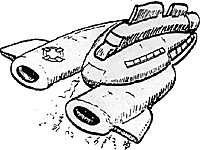 For rubble areas I glued some offcuts of wood onto a cork tile base, textured the wood with ready mixed polyfilla and painted them up as large concrete blocks. The bases were painted and flocked with a tarmac shade, and cluttered up with odd bits of pipe (balsa wood or straws) and wire. Railway trackside terrain is also useful, especially oil tanks and walling sections. The Games Workshop wargames terrain book gives plenty of tips on making craters and bunkers for next to nothing (except time of course). For the largest buildings I use the Games Workshop card buildings (the Imperial Firebase and Imperial Bunker), which cost about £ 12 each. These are made from thick pre-coloured card which are held in place by hard plastic bulkheads - detailed with doors, access hatches and rung ladders.
For rubble areas I glued some offcuts of wood onto a cork tile base, textured the wood with ready mixed polyfilla and painted them up as large concrete blocks. The bases were painted and flocked with a tarmac shade, and cluttered up with odd bits of pipe (balsa wood or straws) and wire. Railway trackside terrain is also useful, especially oil tanks and walling sections. The Games Workshop wargames terrain book gives plenty of tips on making craters and bunkers for next to nothing (except time of course). For the largest buildings I use the Games Workshop card buildings (the Imperial Firebase and Imperial Bunker), which cost about £ 12 each. These are made from thick pre-coloured card which are held in place by hard plastic bulkheads - detailed with doors, access hatches and rung ladders.
Buildings such as these are preferable to solid resin/plaster offerings, because they allow the exact position of miniatures to be determined accurately (although there is always the possibility that the figures skulking in the shadows ready to ambush the unwary are forgotten about, which is probably less likely when counters are used to represent figures in solid buildings). Smaller buildings are constructed from balsa, card and plasticard - embossed plasticard is very useful for this.
Back to Table of Contents -- Lone Warrior #121
Back to Lone Warrior List of Issues
Back to MagWeb Magazine List
© Copyright 1998 by Solo Wargamers Association.
This article appears in MagWeb (Magazine Web) on the Internet World Wide Web.
Other military history articles and gaming articles are available at http://www.magweb.com
